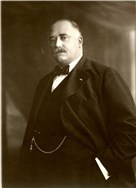 George M. Hendee was the cofounder and president of the Indian Motocycle Company. He was a successful bicycle racer who went on to excel in business and build the world's largest motorcycle company.
George M. Hendee was the cofounder and president of the Indian Motocycle Company. He was a successful bicycle racer who went on to excel in business and build the world's largest motorcycle company.
Born October 2, 1866, in Watertown, Conn., Hendee took up bicycle racing at age 16 and won an astonishing 302 of the 309 races in which he competed (right). Hendee remained involved in bicycling even after he retired from racing, first as a representative for bicycle manufacturers, and later by building his own bicycles in Springfield, Massachusetts.
Due in no small part to his racing fame, his line of bicycles sold well. He also sponsored a number of bicycle racers and events throughout New England. Among the racers he sponsored was Jacob De Rosier, a French-Jewish immigrant who would go on to become one of the earliest stars of motorcycle racing.
Through his involvement in bicycle racing, Hendee witnessed first-hand the excellent performance of the motorized pacing bicycle built by Oscar Hedstrom. Most pacing bikes of the era were crude and unreliable. Hedstrom's engineering ability helped him develop one of the best machines of its type and Hendee quickly recognized Hedstrom's talent.
Hendee told Hedstrom of his dream to mass-produce a motorized bicycle and asked Hedstrom to build a prototype. Interest in the prototype from the press and potential customers encouraged the two men to form the Hendee Manufacturing Company, a partnership with Hendee as president and general manager and Hedstrom as chief engineer and designer.
Hedstrom supervised the manufacturing of "motor bicycles" while Hendee traveled extensively to set up dealerships and arrange financing for the company, which grew at an astounding rate under Hendee's management. By 1912, the Indian Motocycle Company, as it was by then called, was the world's largest motorcycle manufacturer and had moved into a vast, five-story plant in Springfield called the Wigwam (below).
In 1913, the company's production peaked at 32,000 units. But after Ford's Model T was introduced, a car was within the financial reach of many Americans. Motorcycles, once the most economical form of personal transportation, were destined to be marketed as sporting or leisure vehicles, and sales began to fall.
In 1916, at the age of 49, Hendee retired from Indian. Toward the end of his career, he was reported to be at odds with investors and the board of directors over the direction of Indian. He had brought to fruition his dream of building a mass-production motorized bicycle, he was wealthy and happily married, and he decided to leave behind the burdens of running a large company for the life of a country gentleman on his farm in Suffield, Connecticut. In his retirement, he bred Guernsey cattle and volunteered his expertise to the YMCA and the Shriners Hospital for Crippled Children.
Hendee died in 1943 at the age of 76. He will be remembered as one of the fathers of motorcycling.